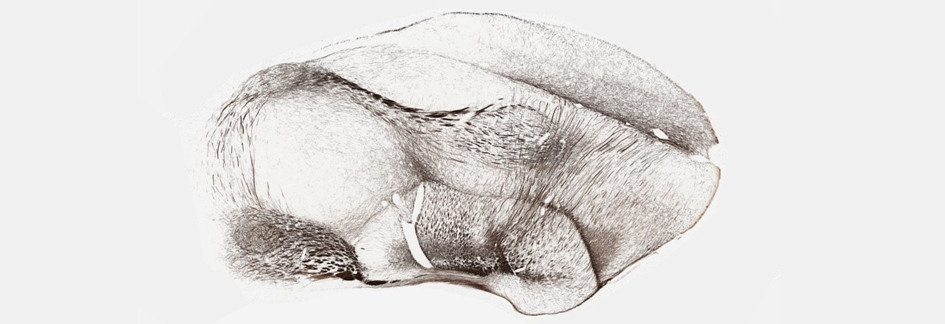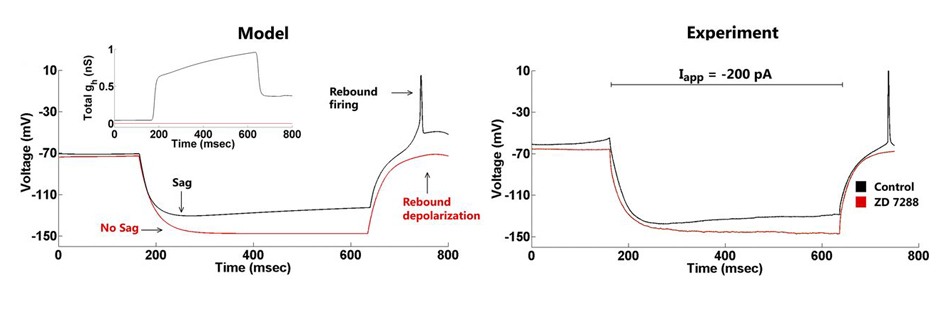In the zebra finch, the brain network that controls singing is dedicated to a single function - learned vocalizations. The song network is also relatively simple, consisting of 5 major forebrain nodes (although a host of minor nodes), with only one primary sensory input (audition) and only one primary motor output (vocalization). Thus, high-fidelity recordings of song directly index neural activity within the song network.
The direct 1:1 linkage between a complex, learned behavior and the activity of a dedicated neural network has led to substantial progress in understanding the general functions of several nodes and pathways within the song network, progress that has been made in laboratories all over the world. A good example, to which we have made several contributions (see Publications page), is the unique role that a cortical premotor region (HVC, the acronym is the name) plays in both auditory and motor aspects of song. Our current laboratory research maintains a focus on the anatomy, physiology, and behavioral functions of HVC. The neurobiological and behavioral data we obtain are subjected to rigorous statistical analysis and then integrated and transformed into the language of mathematics and computation. Along with the laboratory data, the primary research products of our group are testable single-cell and circuit-based biophysical models of how the activity of HVC neurons encodes fundamental processes of perception, learning, memory, and action.
Each faculty member of our group brings an essential skill to our multi-disciplinary research program - Richard Bertram (Mathematics and Biophysical Modeling), Rick Hyson (Electrophysiology and Pharmacology), Frank Johnson (Neuroanatomy and Behavior), Wei Wu (Data Visualization and Statistics). Our students train across labs, developing their own blend of skills, interacting with all of the faculty members in the group at various stages of their training. We are currently training students on 2 projects funded by the National Science Foundation.
Click titles to read overviews.
Parallel Encoding of Sequence and Structure in a Motor Memory Trace (IOS-1456965).
Overview: Observed in nearly all animal forms (and exemplified by human speech) serial order in behavior consists of learning to organize a set of elemental gestural units into a purposeful sequence of action. Adult male zebra finches (Taeniopygia guttata) produce a highly quantifiable example of serial order in behavior (birdsong). Moreover, a premotor cortical region (HVC, proper name) is known to encode a consolidated premotor trace of song. Although consisting of similar cell types, the medial and lateral portions of HVC are hypothesized to encode the sequence (medial HVC) and syllables (lateral HVC) of song in parallel. The research team is testing whether these two dimensions of song are encoded by physiological differences in 1) afferent input to medial and lateral HVC, or 2) the intrinsic network properties of medial and lateral HVC (or a combination of 1 and 2). However, parallel encoding of serial order in behavior should be hierarchical, with traces for sequence in a supervisory position over traces for elemental gestural units. The team will also test whether efferent axons emanating from medial and lateral HVC interact in a hierarchical fashion within vocal-motor cortex. Results will elucidate a network architecture for serial order in behavior and provide a computational platform to understand how learning new sequences shapes such memory architectures.
Developmental Learning Involves Nonsynaptic Plasticity (IOS-1656360).
Overview: Much is known about the neural circuits that underlie song learning. Consequently, we know where to look for learning-induced changes (an area named HVC), but we do not know what neural changes encode the auditory memory of the tutor song. The proposed research tests the novel hypothesis that changes in specific ionic currents in HVC neurons contribute to the encoding of auditory memories. Songbird auditory learning can be readily manipulated by controlling exposure to a tutor. Preliminary data show that the intrinsic properties of HVC neurons change in an experience-dependent manner during song development. The research team’s recent characterization and modeling of the ionic currents that determine the physiology of HVC neurons in the adult finch now allows for the proposed developmental studies. Proposed studies will test hypotheses about the developmental emergence of specific ionic currents as they relate to sensory learning. This will lead to testable hypotheses about the underlying molecular mechanisms responsible for this learning. As part of this project, the team will also correct mistaken views about HVC of female zebra finches. Long thought to lack male-typical connectivity, new data show that female and male HVC have the same cell types and patterns of extrinsic connectivity. Since females show auditory learning of tutor song, but do not sing, analysis of female HVC will provide a critical test of the proposed hypotheses. Together, the proposed experiments will provide clues to fundamental questions of how early sensory information is stored as a stable memory trace for a lifetime.





